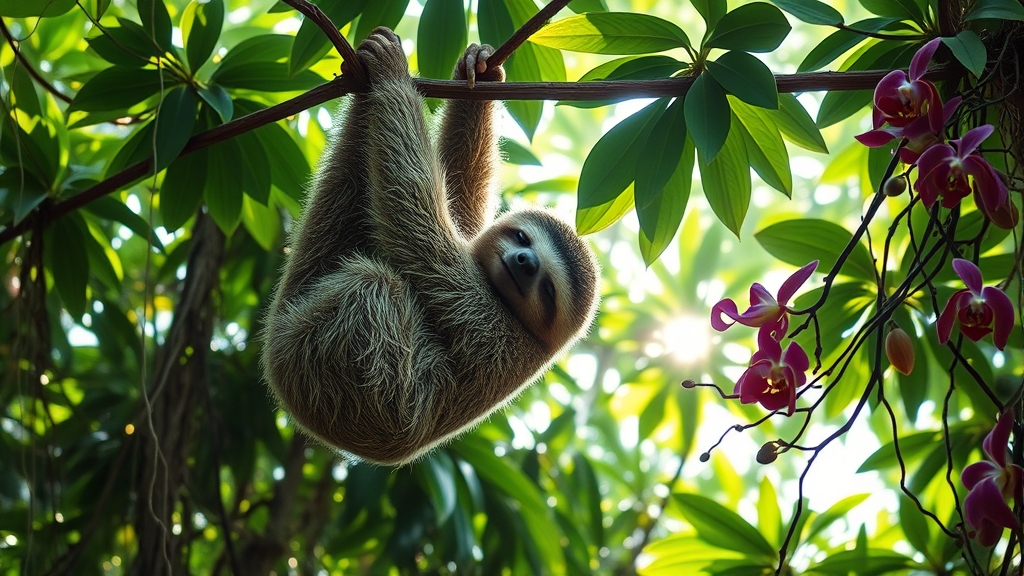You might think sloths are slow because they’re lazy, but their slow pace is a clever survival trick. They conserve energy by moving very slowly, which reduces their need for food, while their specialized digestion helps process tough leaves efficiently. Their camouflage blends perfectly with leafy surroundings, avoiding predators like jaguars and eagles. Their habitat high in the trees offers safety and easy access to food. Stick around to discover more about these fascinating, intentional survivors.
Key Takeaways
- Their slow movements conserve energy, aligning with their low-calorie leaf-based diet.
- Camouflage and slow pace help them avoid predators in dense forest habitats.
- Living high in the treetops minimizes ground predator encounters.
- Specialized digestion processes efficiently extract nutrients from tough leaves.
- Brief, cautious ground trips reduce exposure to ground-based predators.

Sloths may move slowly, but they’ve mastered the art of survival in the treetops of Central and South America. Their unique lifestyle revolves around a specialized sloth diet, primarily consisting of leaves, which are tough to digest but provide the necessary nutrients they need to thrive. Because leaves are low in calories, sloths conserve energy by moving very little and spending most of their time hanging peacefully among the branches. Their diet influences their slow movements, as they need to minimize energy expenditure, making their slow pace a strategic choice rather than a flaw. This diet also affects their overall health, as they have a slow metabolism that allows them to survive on such nutrient-sparse food sources. You’ll notice that sloths often nibble on the same branches repeatedly, which helps them maximize the nutritional value of their limited food intake. Their slow metabolism is an adaptation that enables them to efficiently utilize the nutrients from their diet. Additionally, their specialized digestive system is finely tuned to process the high-fiber content of leaves, which is essential for their nutrition. This adaptation is crucial because their diet is low in energy, requiring a highly efficient digestion process. Moreover, their ability to conserve energy is vital for their long-term survival in their environment.
When it comes to their sloth habitat, these creatures are perfectly adapted to life high in the canopy of dense forests. They prefer areas with abundant trees that provide both food and cover from predators. You’ll find them in the lush rainforests, where the thick canopy offers a safe haven from many predators like jaguars and eagles. Their habitat isn’t just about food; it’s also about safety and comfort. The branches they cling to are often sturdy enough to support their weight, and the dense foliage offers excellent camouflage, making it difficult for predators to spot them. Their arboreal lifestyle means they rarely descend to the ground, which further reduces their risk of danger. When they do come down, it’s usually to urinate or defecate, but they are cautious during these brief trips, aware of the threats lurking below. Their arboreal lifestyle is a key element in their survival, allowing them to avoid many ground-based predators.
Living in this specific habitat has shaped every aspect of their behavior and physiology. You might think their slow movements are a disadvantage, but in reality, they are an essential part of their survival strategy. Their camouflage, combined with their slow pace, helps them blend into the leafy environment, making it harder for predators to detect them. Their habitat also provides the perfect environment for their specialized diet, ensuring they remain close to the leaves they need to eat daily. By understanding their habitat and diet, you can appreciate how every aspect of a sloth’s life is finely tuned for survival in the treetops. It’s a slow, deliberate existence, but one that’s remarkably effective in ensuring they live out their days high above the forest floor. Moreover, their ability to adapt to their environment demonstrates the importance of specialized behaviors that contribute to their longevity.
Frequently Asked Questions
How Do Sloths Communicate With Each Other in the Wild?
You might wonder how sloths communicate in the wild. They use a variety of sloth vocalizations and subtle communication signals to stay connected. These vocalizations, like grunts and high-pitched calls, help alert others to danger or mark territory. You’ll notice their communication signals are quite slow and quiet, matching their relaxed lifestyle. This method guarantees they stay aware of each other without attracting predators or wasting energy.
What Are the Main Predators of Sloths?
In the forest canopy, you’ll find that sloths face predators like jaguars, ocelots, and large birds of prey. To avoid these threats, they rely on their slow movements and camouflage, blending into the leaves and branches. Their quiet, deliberate lifestyle helps them stay hidden, reducing the chance of predator detection. By staying high in the canopy, they minimize encounters with ground-based predators, enhancing their survival chances.
How Long Can Sloths Survive Without Food or Water?
Think of your body as a delicate balance beam, and now imagine a sloth’s slow digestion as a masterful dance with time. Without food or water, it can survive for up to a week or more, thanks to water conservation strategies that slow its metabolism. This patience allows the sloth to endure harsh times, turning scarcity into a silent witness of resilience, much like a quiet, enduring river carving through stone.
Do Sloths Have Any Unique Sensory Adaptations?
You might wonder if sloths have any unique sensory adaptations. They do—sloths possess specialized sensory organs that enhance their environmental awareness. Their keen sense of smell helps them find food, while their eyesight is adapted for low-light conditions in the canopy. These sensory organs enable sloths to detect threats and navigate their environment safely, despite their slow movements. This heightened environmental awareness is essential for their survival in dense, predator-rich habitats.
How Do Sloths Navigate Their Environment Despite Their Slow Movements?
You might wonder how sloths navigate their environment despite their slow movements. They rely on keen sensory navigation, using their excellent sense of touch and vision to find and follow arboreal pathways. Their strong, curved claws help them grip branches securely, allowing precise movements. This combination of sensory cues and physical adaptations helps them move carefully and efficiently through the treetops, ensuring they can access food and avoid predators even at a sluggish pace.
Conclusion
Just like the gentle sloth hanging peacefully from its tree, you learn that patience and calm can be your greatest strengths. Embrace your own slow, deliberate pace, allowing life’s obstacles to unfold naturally. Remember, sometimes the strongest survival tactic is simply hanging on, trusting in your own resilience. Like the sloth’s quiet grace, your steady perseverance can turn life’s challenges into symbols of unwavering strength, guiding you through even the toughest branches.







